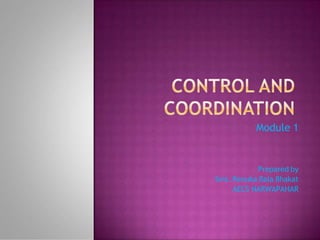
sodapdf-converted.docx
- 1. Module 1 Prepared by Smt. Renuka Bala Bhakat AECS NARWAPAHAR
- 2. ⦿ Nervous system controls and coordinates activities produced with the help of electrical impulses produced in response to external and internal stimuli.
- 3. . A stimulus is an agent , factor, chemical or change in external or internal environment which brings about a reaction in the organism.
- 4. Response is the reaction of an organism to a stimulus.
- 5. ⦿ Receptors are cells ,tissues or organs which are capable of receiving a particular stimuli and initiate response .
- 6. ⦿ 1.Gustatoreceptors – They are located on the mouth and tongue and detect taste . ⦿ 2. Thermoreceptors - They are located on the skin and detect heat and cold . ⦿ 3.Olfactoreceptors – Olfactoreceptors are located in the nose and detect smell. ⦿ 4.Photo receptors – The receptors which detect light are called photoreceptors. ⦿ 5.Phonoreceptors – They are located in the ear and detect sound .
- 7. ⦿ A nerve cell is called neuron .
- 8. A neuron has three parts – 1. Cell body or soma- It has abundant cytoplasm and other cell organelles but lacks centrioles. 2. Dendrites They pick up nerve impulses and also help in joining one neuron with the other. 3. Axon – It carries impulses away from the cell body. The axon terminals end in muscle fibres , glands or combine with dendrites of other neurons .
- 9. ⦿ An impulse travels along the neuron pathways as electrical charges move across each neural cell membrane. Ions moving across the membrane cause the impulse to move along the nerve cells. When the impulse reaches the end of one neuron (the axon), the impulse reaches a synapse. A synapse is the space between neurons.
- 11. ⦿ The neuromuscular junction (NMJ) is a synaptic connection between the terminal end of a motor nerve and a muscle (skeletal/ smooth/ cardiac). It is the site for the transmission of action potential from nerve to the muscle.
- 12. ⦿ The brain is divided into three parts – forebrain , midbrain and hindbrain.
- 14. ⦿ The forebrain consists of the Cerebrum, Thalamus and Hypothalamus. ⦿ It is the main thinking part of the brain and controls the voluntary actions. The forebrain processes sensory information that is collected from the various sense organs such as ears, eyes, nose, tongue, skin. It is because of the presence of forebrain, humans are placed at the highest level in the animal chain.
- 15. ⦿ The cerebrum is the biggest part of the brain. This part we associate with higher brain functions such as thinking and action. It contains the cerebral cortex and other subcortical structures. The cerebral cortex is highly wrinkled and makes the brain very efficient. Now the cerebral cortex again divides into four divisions called lobes. They are: ⦿ Frontal lobe –Is associated with parts of speech, reasoning, problem-solving, planning, movement and emotions ⦿ Parietal lobe – We associate parietal lobe with recognition, orientation, and perception of stimuli ⦿ Occipital lobe – Is responsible for visual processing ⦿ Temporal lobe – Finally temporal lobe is associated with memory, speech perception and recognition of auditory stimuli ⦿ The cerebrum is divided into two halves by a deep furrow. These halves are the left and right hemispheres. Each side functions slightly different from the other, even though they are symmetrical. So the right hemisphere links to creativity whereas the left hemisphere relates to logic abilities. And Corpus callosum connects the two hemispheres.
- 16. ⦿ The midbrain connects the forebrain and the hindbrain. It acts as a bridge and transmits signals from hindbrain and forebrain. It is associated with motor control, vision, hearing, temperature regulation, alertness.
- 17. ⦿ It consists of ⦿ a) Cerebellum – It coordinates muscular activities and maintains posture and balance of the body. ⦿ B) Pons – It connects the cerebrum , cerebellum and medulla oblongata. It acts as relay centre among different parts of brain . ⦿ C) Medulla oblongata - The medulla oblongata is a small structure present in the lowest region of the brain. It mainly controls the body’s autonomic functions such as heartbeat, breathing, and digestion. It plays a primary role in connecting the spinal cord, pons and the cerebral cortex.
- 18. ⦿ The brain is protected by the bones of the skull and by a covering of three thin membranes called meninges. The brain is also cushioned and protected by cerebrospinal fluid. This watery fluid is produced by special cells in the four hollow spaces in the brain, called ventricles.
- 19. ⦿ When a nerve impulse reaches the muscle the muscle fibre must move. The muscle cells will move by changing their shape so that they shorten. Muscle cells have special proteins that change both their shape and their arrangement in the cell in response to nervous electrical impulses. When this happens new arrangements of these proteins give the muscle cells a shorter form.
- 20. ⦿ Reflex action is a sudden and involuntary response to stimuli. It helps organisms to quickly adapt to an adverse circumstance that could have the potential to cause bodily harm or even death. Pulling our hands away immediately after touching a hot or cold object is a classic example of a reflex action.
- 21. ⦿ The pathway taken by a stimulus to travel from receptor organ to effector organ is called reflex arc.